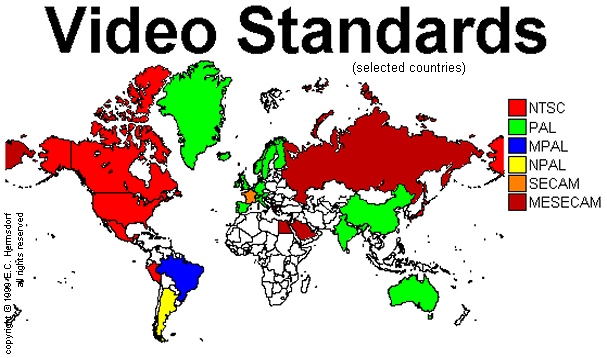TC03 - Video editing
| Site: | Tenegen |
| Course: | TC03 - Educational ICT tools |
| Book: | TC03 - Video editing |
| Printed by: | Guest user |
| Date: | Friday, 26 December 2025, 2:27 AM |
Description
-
Video editing
 Learning objectives
Learning objectives
When you have completed this session, you should be able to
- create a small video and edit it,
- list the common standards.
Digital Video Technology
Analogue and digital video technology is based on television broadcasting. Therefore it is good to know some of the basic principles of television.
TV picture is made from a series of still pictures. The pictures are transmitted to the receivers when divided into lines. These lines are displayed by electron rays onto the phosphorous coating of the tube surface. In order to achieve a picture free of b link ing, and for increasing the frequency of the screen interlaced scanning is used. Electron rays first display the odd lines then returns to the top of the screen and the even lines are displayed between the odd ones.
This method is known as interlaced scanning.
A half TV screen image is called field while a full TV picture is called frame.
For color image transmitting the three basic colors (RGB: red, green, blue) must be transmitted beside the brightness value (Y). When knowing the brightness value and two other basic colors the third one can also be determined. Therefore in practice the Y value and the R-Y and B-Y difference is transmitted. This method is called YUV coding.
There are three color TV standards are used in the world. The most important specifications are the followings:

NTSC (National Television System Committee)
The oldest norm used in the United States and Japan.
The number of lines forming the picture is 525
Refreshing frequency 59,95 Hz
Half refreshing frequency 29,975 Hz
Line frequency 15734,2657 Hz
Number of visible lines 475
(Only 475 lines can be seen because during half picture refreshing (25 line time) no video signal can be displayed.)
PAL (Phase Alternating Line)
It was created by modifying NTSC norm in order to eliminate the sensitivity of the successor for transmission phase torsion.
The number of lines forming the picture 625
Refreshing frequency 50 Hz
Half refreshing frequency 25 Hz
Line frequency 15625 Hz
Number of visible lines 575
SECAM (Séquentiel Couleur á Memoire)
Norm introduced in France. The effect of phase torsion is decreased when switching from line to line only one color difference signal is transmitted.
In other parameters it is the same as PAL norm.
Digitizing Analogue
 Learning objectives
Learning objectives
When you have completed this session, you should be able to
- define different compression methods.
Digitizing Analogue Video Signal
Digitizing analogue video signals, similarly as digitizing audio signals, is done by sample taking. The picture is also dissolved into basic units, pixels and the difference of brightness and color values are quantized. Audio signals are usually digitized simultaneously with video signals. Images and sounds are mostly stored in AVI (Audio Video Interleave) format.
During the video digitizing process a series of 16 bit color depth YUV coded bitmaps are recorded which means a huge amount of data. In case of a 25 frames / sec 768 x 576 pixel resolution recording 22 MByte data must be stored in every second.
Video Compressing Methods
The simplest way of compressing is the decreasing of definition. 384 x 288 pixel definition is often used but the information to be stored is being too much even this way. Many ways have been developed for compressing. Some of them are described here below.
Huffman-coding
This method is widely used in computer technology. It has a major significance in video technology because video signals can be compressed this way without loss approximately in 3 to 1 ratio.
Its most known format is HuffYUV.
MJPEG (Motion JPEG)
The most used compressing method for digitizing. Practically it creates a series of compressed JPEG format bitmaps. The compressing is made by DCT (Discreet Cosinus Transformation) in an approximate ratio of 10 to1.
Most video digitizing cards support this method.
Intel Indeo
It uses more coding processes at once. Quality wise it is similar to MJPEG but it supports key-bitmap compression too known for MPEG.
MPEG-1
It uses the small difference between the contents of subsequent bitmaps. Usually entirely stores every twelfth bitmaps only (key-bitmap). Only the difference related to the previous bitmap is stored For bitmaps in between (delta-bitmap). Key-bitmaps are compressed by DCT method.
A disadvantage of MPEG compression is that cutting and editing can only be done at key bitmaps. For this reason it is usually used as a final format.
MPEG-2
It is a further development of MPEG-1. Used for compressing DVD movies, cable TV systems and satellite broadcasting.
MPEG-3
Developed for HDTV applications. It has completely disappeared by now. It has been merged with MPEG-2.
MPEG-4
This is the most advanced MPEG compression method. Originally a part of ASF (Advanced Streaming Format) which makes video signal transmits efficient via Internet. Because of its high efficiency and good quality it becomes more widely used for other applications too.
Video Tutorial
![]() Exercises
Exercises
Watch the tutorial and create a video clip!